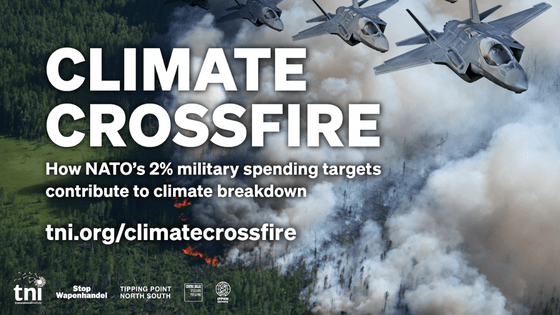NATO’s goal of 2% spending of GDP on the military will accelerate climate breakdown by diverting millions of dollars from climate finance and increasing greenhouse gas emissions, concludes a new report that urgently calls for a ‘climate dividend’ similar to the ‘peace dividend’ that was won with the end of the Cold War.
The report, Climate Crossfire, produced by the international research organization, Transnational Institute, together with Stop Wapenhandel (Netherlands) and Tipping Point North South (UK) estimates the likely financial implications as well as increased greenhouse gas emissions that would result if all NATO members meet their commitment to increase military spending to a minimum of 2% of GDP.
The report finds that:
- NATO’s military spending this year – $1.26 trillion- would pay for 12 years of promised climate finance of $100 billion a year.
- If all NATO members meet its 2% military spending targets, it would divert an estimated additional US$2.57 trillion by 2028 away from climate spending, enough to pay for climate adaptation costs for all low- and middle-income countries for seven years.
- NATO’s estimated military carbon footprint this year – 205 million tCO2e – is comparable to the total annual greenhouse gas emissions of many countries. If NATO’s militaries were a country, it would rank 40th in the world in terms of greenhouse gas emissions.
- If all NATO members meet its 2% military spending targets, this would lead to an estimated additional 467 million tonnes of greenhouse gas emissions.
- NATO members export arms to 39 of the 40 most climate-vulnerable countries, fuelling conflict and repression at a dangerous moment of climate breakdown.
NATO’s spending goals have undoubtedly gained momentum as a result of Russia’s full-scale illegal invasion of Ukraine, however even before achieving the 2% target, in 2021 NATO overall spent more than 16 times as much as Russia and its allies in the Collective Security Treaty Organization (CSTO, which includes Armenia, Belarus, Kazakhstan, Kyrgyzstan, Russia, and Tajikistan). Russia has increased its military expenditure to a projected $102 billion in 2023, but this would still be less than a twelfth of NATO’s collective expenditure of $1.26 trillion.
The biggest danger of NATO’s 2% military spending goals is that it is encouraging a worldwide arms race. Global military spending in 2022 reached record highs of $2.24 trillion. Our report last year, Climate Collateral, revealed that the richest nations (known as ‘Annex 2’ countries in UN climate negotiations) are spending 30 times as much on military as on climate finance.
Nnimmo Bassey, former president of Friends of the Earth International and director of the Health of Mother Earth Foundation, Nigeria says in a foreword to the report:
‘Wars kill people, extinguish biodiversity, and destroy the infrastructure that could otherwise provide safeguards in the face of extreme weather events. Warfare is an act of climate denial.’
Co-author of the report, Nick Buxton of Transnational Institute says:
‘This report shows that the climate has tragically become the latest victim in the crossfire of war. We have a closing window of time to address the climate crisis, but the world’s political leaders are more focused on arming themselves to the teeth than prioritising climate action. NATO’s 2% minimum spending goals are adding fuel to the climate fire, diverting much needed resources and increasing greenhouse emissions. We urgently need to de-escalate tensions and find peaceful solutions to conflicts if we are to defend our planet. There is no secure nation on an unsafe planet.’
Contact: Nick Buxton | +1 530 902 3772 /California | nick@tni.org | @nickbuxton
Co-authors of the report, Dr Ho-Chih Lin and Deborah Burton of Tipping Point North South say:
‘The military like to portray themselves today as positive climate actors, but they have been the biggest institutional user of fossil fuels. Oil-free fighter jets or electric tanks do not exist and there is nothing realistic on the horizon that will make a meaningful dent in military carbon footprint. Not in our lifetime and certainly not by 2050. The stark reality facing politicians is that to green the military, we need to reduce military spending significantly and this will require a new approach to security, one invested in building diplomacy, peace and climate resilience rather than war.’
Contact: Deborah Burton | +44 7779 203455/ UK | deborah@tippingpointnorthsouth.org
Wendela de Vries, a researcher at StopWapenhandel, Dutch Campaign Against the Arms Trade says: ‘High military budgets lead to more emissions, which is not making the world safer. The big winner is the arms industry whose profits are skyrocketing. As the planet reaches a climate tipping point, it is insane that we are investing in making arms dealers even richer, rather than protecting those whose lives are being devastated by climate breakdown
Contact: Wendela de Vries | +31 (0) 6 506 522 06/Netherlands | w.de.vries@stopwapenhandel.org | @CTWnl
Notes
- The full report can be found at https://www.tni.org/climatecrossfire. The executive summary is also available in Spanish, French, Catalan and German.
- Total global military expenditure increased by 3.7 per cent in real terms in 2022, to reach a new high of $2240 billion https://www.sipri.org/media/press-release/2023/world-military-expenditure-reaches-new-record-high-european-spending-surges
Deborah Burton of Tipping Point North South attended COP27 and spoke at a packed UNFCCC side event, Dealing with military and conflict related emissions under the UNFCCC, on 9 November 2022. She hopes to attend COP28 in UAE.

